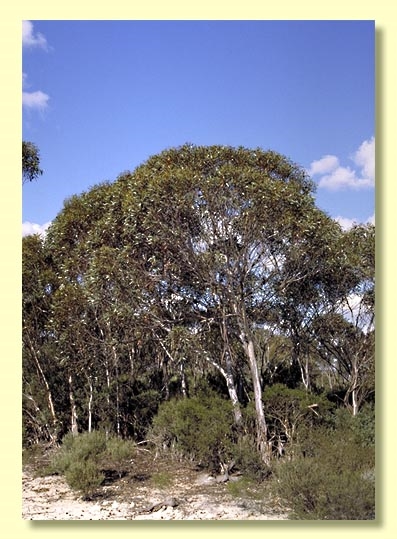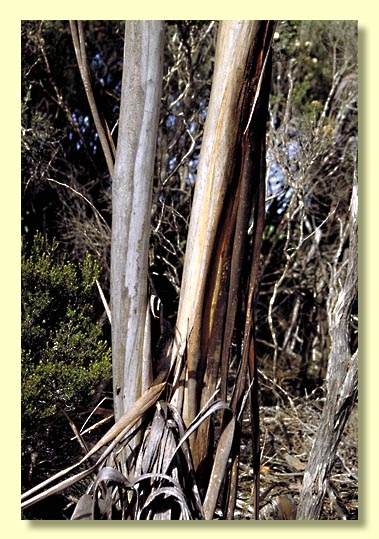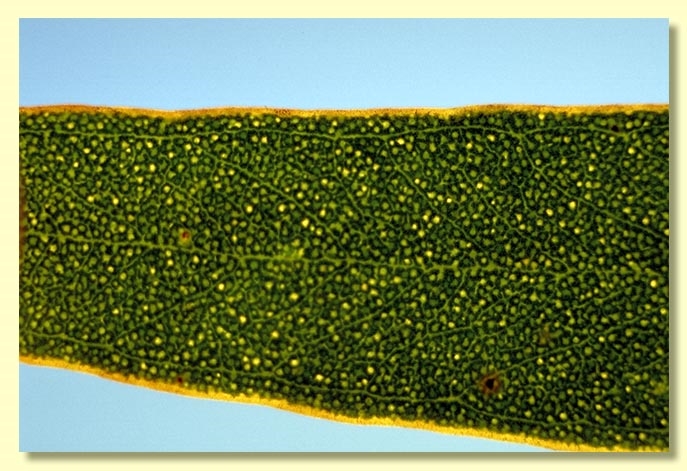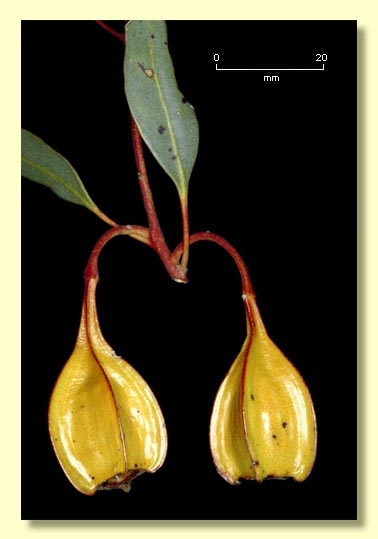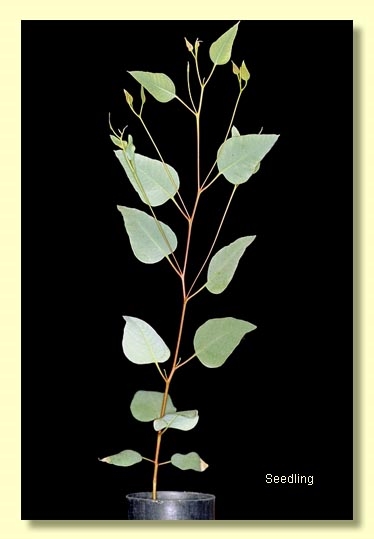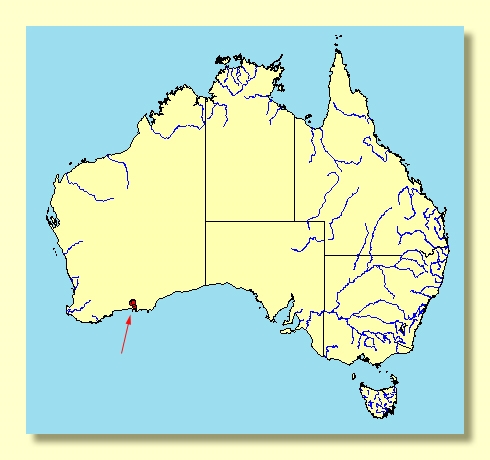Euclid - Online edition
Eucalyptus dolichorhyncha
Eucalyptus | Symphyomyrtus | Dumaria | Tetrapterae
Bark smooth throughout, pale grey over pale orange to pale brown, shedding in broad ribbons.
Branchlets lacking oil glands in the pith.
Juvenile growth (coppice or field seedlings to 50 cm): stems rounded to square in cross-section; juvenile leaves always petiolate, alternate, ovate to lanceolate, 3–10 cm long, 2–6 cm wide, greyish green and dull but becoming green higher up stem. Adult leaves alternate, petioles 0.8–1.6 cm long; blade lanceolate to oblong, 4.5–9 cm long, 1–2.7 cm wide, base tapering to petiole, margin entire, apex pointed to rounded, concolorous, dull and slightly bluish green at first maturing glossy green, penniveined or with side veins acute, reticulation dense and erose, or obscure, intramarginal vein fairly close to margin, oil glands mostly intersectional.
Inflorescence axillary unbranched, peduncles widening distally, pendulous, 2–4.2 cm long, bud solitary, pedicel 0.8–1.5 cm long. Mature buds oblong in outline and square in cross-section with wings at the corners, smooth in between (3.2–5.5 cm long, 1–1.8 cm wide), red in colour, scar present, outer operculum "shed" at bud-size approximately a fifth mature size and often remains stuck to apex of inner operculum as a black "scab", inner operculum prominently beaked (operculum 1–3.2 cm long), stamens inflexed, anthers oblong to globoid, versatile, sub-basifixed, dehiscing by longitudinal slits, style long and straight, stigma tapered to rounded, locules 3 or 4, the placentae each with 6 or 8 vertical rows of ovules. Flowers yellow.
Fruit pedicellate (pedicels 0.8–1.5 cm long), oblong, square in cross-section and winged, 2.9–4 cm long, 1.3–3 cm wide, disc descending vertically, valves 3 or 4, enclosed.
Seeds black to blackish brown, 2–5 mm long, more or less pyramidal to flattened and four-angled with a conspicuous marginal flange, dorsal surface scarcely reticulate, hilum terminal.
Cultivated seedlings (measured at ca node 10): cotyledons reniform; stems rounded to square in cross-section; leaves always petiolate, opposite for 4 or 5 nodes then alternate, ovate, 2.8–7 cm long, 2–4.5 cm wide, dull, green.
Flowering has been recorded in January, February, April, August, September and December.
E. dolichorhyncha, once included in E. forrestiana, is a popular ornamental widely cultivated in southern Australia.
A mallet endemic to Western Australia, restricted to a small area south of Salmon Gums to north-east of Esperance where common on flats or slightly rising ground with whitish to yellowish sandy clay soil. It has smooth bark and glossy, green to olive-green adult leaves and with obvious large red buds with prominent beak on the operculum, but the flowers (stamens) are yellow.
Eucalyptus dolichorhyncha belongs in Eucalyptus subgenus Symphyomyrtus section Dumaria because the buds have two opercula, stamens are strongly inflexed, ovules are in six or eight rows on the placentae and cotyledons are reniform. E. dolichorhyncha forms a small subgroup (series Tetrapterae) with E. stoatei, E. forrestiana and E. tetraptera, all with single-budded inflorescences that are ultimately red, all lacking oil glands in the pith of the branchlets, and with blackish pyramidal seed.
E. dolichorhyncha is distinguished from its close relatives by the combination of slenderly beaked operculum and four-winged buds and fruit that are square in cross-section. The species most often confused with E. dolichorhyncha is E. forrestiana, but the latter has a shallow disc-like operculum that is never beaked. Otherwise, it is very similar. E. dolichorhyncha is often cultivated in southern Australia as an ornamental and has frequently been sold under the name E. forrestiana.

